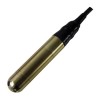Resistive strain gauge device.
A strain gauge is a device for measuring an applied force. The electrical resistance or impedance of a strain gauge will change when a strain gauge element is stretched or compressed. Strain gauges are incorporated into electrical circuits designed to exploit the sensitivity of the strain gauge, so that the resulting change in electrical resistance is converted into a measurable voltage which can be sent to other electronics for further processing.
Featured strain gauge sensor technology related products
 Surface water hydrostatic level sensor for shallow stream - Submersible hydrostatic level sensor and a vented terminal box with surge protection provide an accurate and robust solution for monitoring water levels in shallow streams.
Surface water hydrostatic level sensor for shallow stream - Submersible hydrostatic level sensor and a vented terminal box with surge protection provide an accurate and robust solution for monitoring water levels in shallow streams. SWL Marine Bronze Submersible Level Sensor - Analogue output sensor for immersing in seawater to determine depth or change in water level by measuring hydrostatic pressure.
SWL Marine Bronze Submersible Level Sensor - Analogue output sensor for immersing in seawater to determine depth or change in water level by measuring hydrostatic pressure.
Glossary of Sensor Technology technical terms
- BFSG – Bonded Foil Strain Gauge
- Bourdon Tube
- Capacitive Fluid Level Measurement
- Ceramic Pressure Sensors
- Conductive Fluid Level Detection
- Doppler Effect Flow Measurement
- Float Fluid Level Detection
- LVDT – Linear Variable Differential Transformer
- Paddle Wheel Sensor
- Piezoresistive Strain Gauges
- Positive Displacement Flow Measurement
- Radar Distance Sensing
- SOI – Silicon on Insulator
- Thin Film
- Transit Time Flow Measurement
- Turbine Rotor Sensor
- Ultrasonic Distance Sensing
- Ultrasonic Flow Velocity Sensors
- Vibrating Tuning Fork Fluid Level Detection
- Vortex Flow Measurement
- Wheatstone Bridge Strain Gauge


